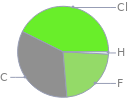Input interpretation

1, 2, 3-trichloro-5-(trifluoromethyl)benzene | elemental composition
Result

Find the elemental composition for 1, 2, 3-trichloro-5-(trifluoromethyl)benzene in terms of the atom and mass percents: atom percent = N_i/N_atoms × 100% mass percent = (N_im_i)/m × 100% Plan: • Write the chemical formula and gather atomic masses from the periodic table. • Determine values for N_i, m_i, N_atoms and m using these items. • Finally, compute the percents and check the results. Write the chemical formula: Cl_3C_6H_2CF_3 Use the chemical formula to count the number of atoms, N_i, for each element and find the total number of atoms, N_atoms, per molecule: | number of atoms C (carbon) | 7 Cl (chlorine) | 3 F (fluorine) | 3 H (hydrogen) | 2 N_atoms = 7 + 3 + 3 + 2 = 15 Divide each N_i by N_atoms to calculate atom fractions. Then use the property that atom fractions must sum to one to check the work: | number of atoms | atom fraction C (carbon) | 7 | 7/15 Cl (chlorine) | 3 | 3/15 F (fluorine) | 3 | 3/15 H (hydrogen) | 2 | 2/15 Check: 7/15 + 3/15 + 3/15 + 2/15 = 1 Compute atom percents using the atom fractions: | number of atoms | atom percent C (carbon) | 7 | 7/15 × 100% = 46.7% Cl (chlorine) | 3 | 3/15 × 100% = 20.0% F (fluorine) | 3 | 3/15 × 100% = 20.0% H (hydrogen) | 2 | 2/15 × 100% = 13.3% Look up the atomic mass, m_i, in unified atomic mass units, u, for each element in the periodic table: | number of atoms | atom percent | atomic mass/u C (carbon) | 7 | 46.7% | 12.011 Cl (chlorine) | 3 | 20.0% | 35.45 F (fluorine) | 3 | 20.0% | 18.998403163 H (hydrogen) | 2 | 13.3% | 1.008 Multiply N_i by m_i to compute the mass for each element. Then sum those values to compute the molecular mass, m: | number of atoms | atom percent | atomic mass/u | mass/u C (carbon) | 7 | 46.7% | 12.011 | 7 × 12.011 = 84.077 Cl (chlorine) | 3 | 20.0% | 35.45 | 3 × 35.45 = 106.35 F (fluorine) | 3 | 20.0% | 18.998403163 | 3 × 18.998403163 = 56.995209489 H (hydrogen) | 2 | 13.3% | 1.008 | 2 × 1.008 = 2.016 m = 84.077 u + 106.35 u + 56.995209489 u + 2.016 u = 249.438209489 u Divide the mass for each element by m to calculate mass fractions. Then use the property that mass fractions must sum to one to check the work: | number of atoms | atom percent | mass fraction C (carbon) | 7 | 46.7% | 84.077/249.438209489 Cl (chlorine) | 3 | 20.0% | 106.35/249.438209489 F (fluorine) | 3 | 20.0% | 56.995209489/249.438209489 H (hydrogen) | 2 | 13.3% | 2.016/249.438209489 Check: 84.077/249.438209489 + 106.35/249.438209489 + 56.995209489/249.438209489 + 2.016/249.438209489 = 1 Compute mass percents using the mass fractions: Answer: | | | number of atoms | atom percent | mass percent C (carbon) | 7 | 46.7% | 84.077/249.438209489 × 100% = 33.71% Cl (chlorine) | 3 | 20.0% | 106.35/249.438209489 × 100% = 42.64% F (fluorine) | 3 | 20.0% | 56.995209489/249.438209489 × 100% = 22.85% H (hydrogen) | 2 | 13.3% | 2.016/249.438209489 × 100% = 0.8082%
Mass fraction pie chart

Mass fraction pie chart